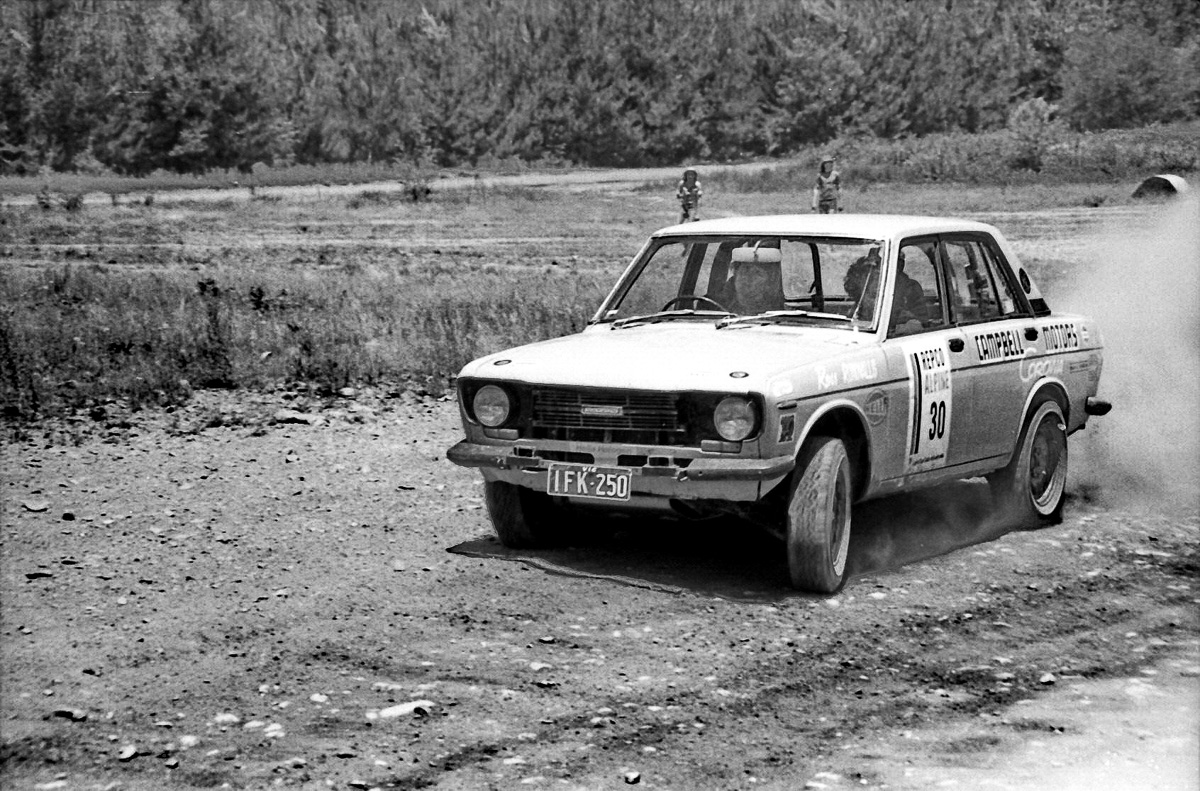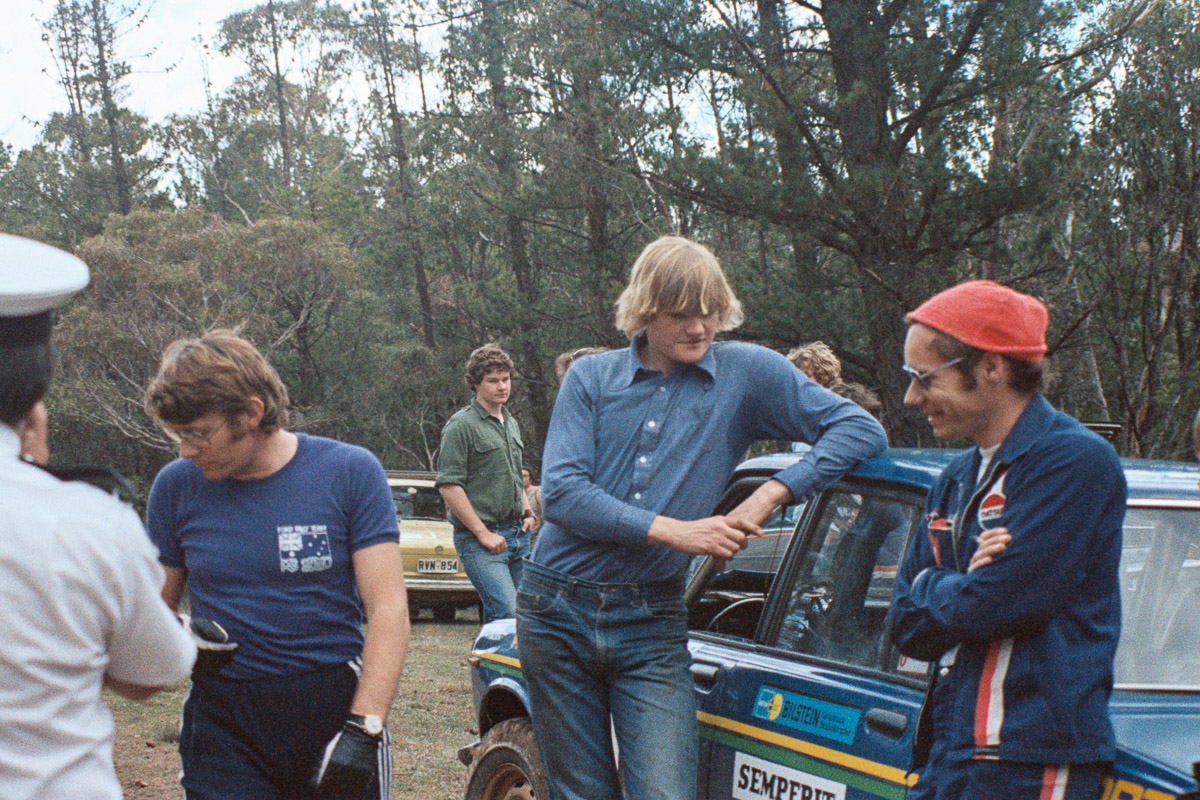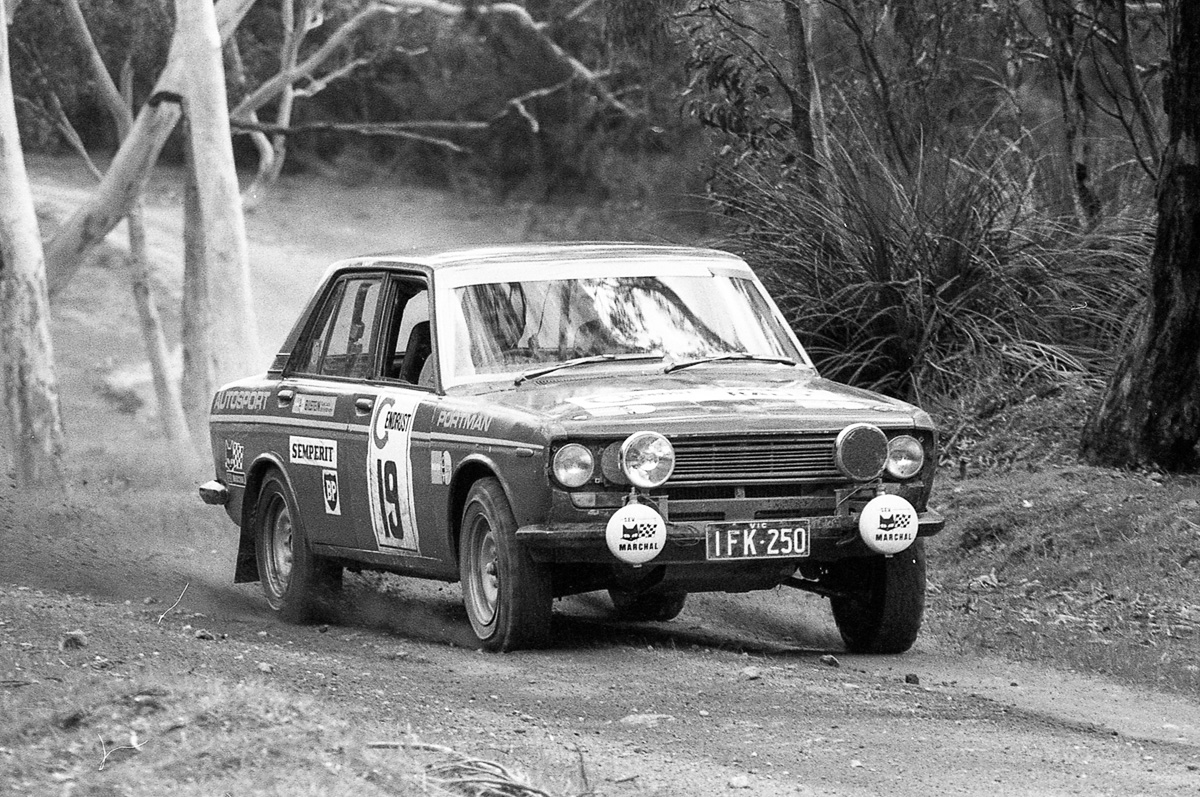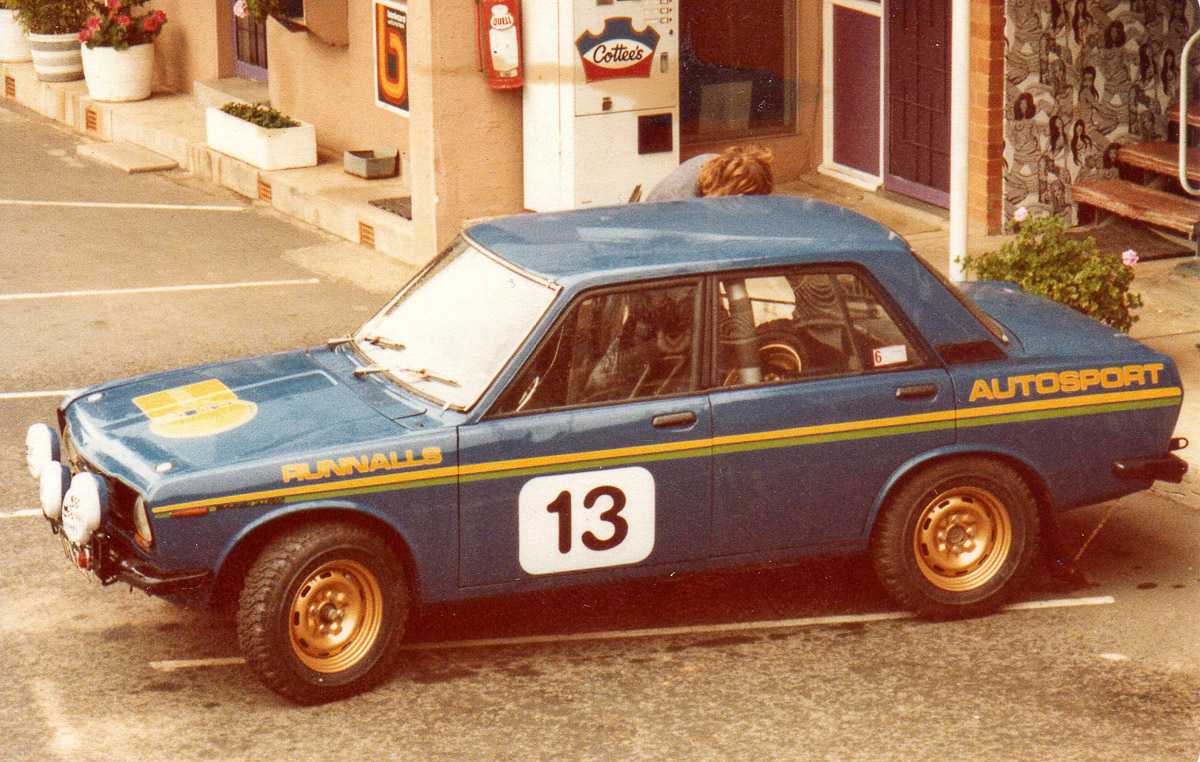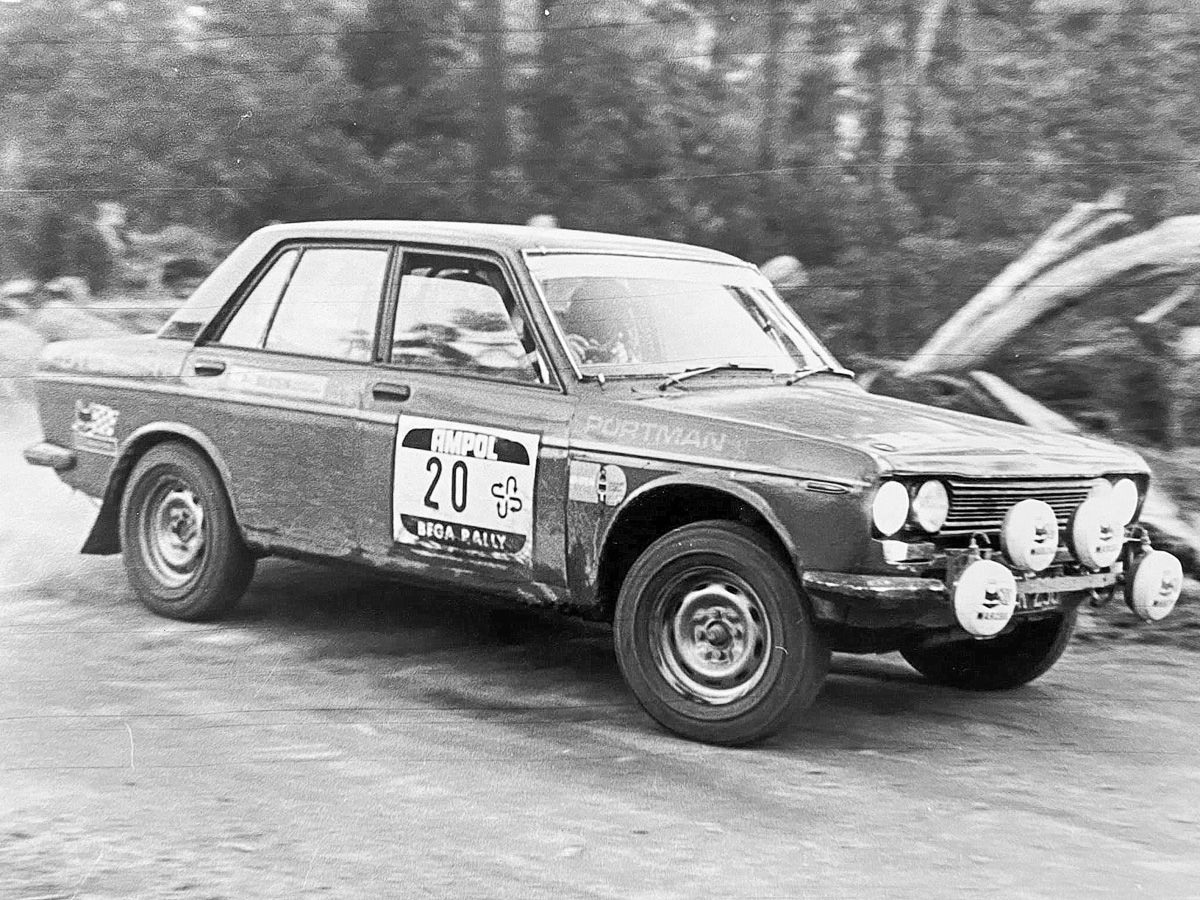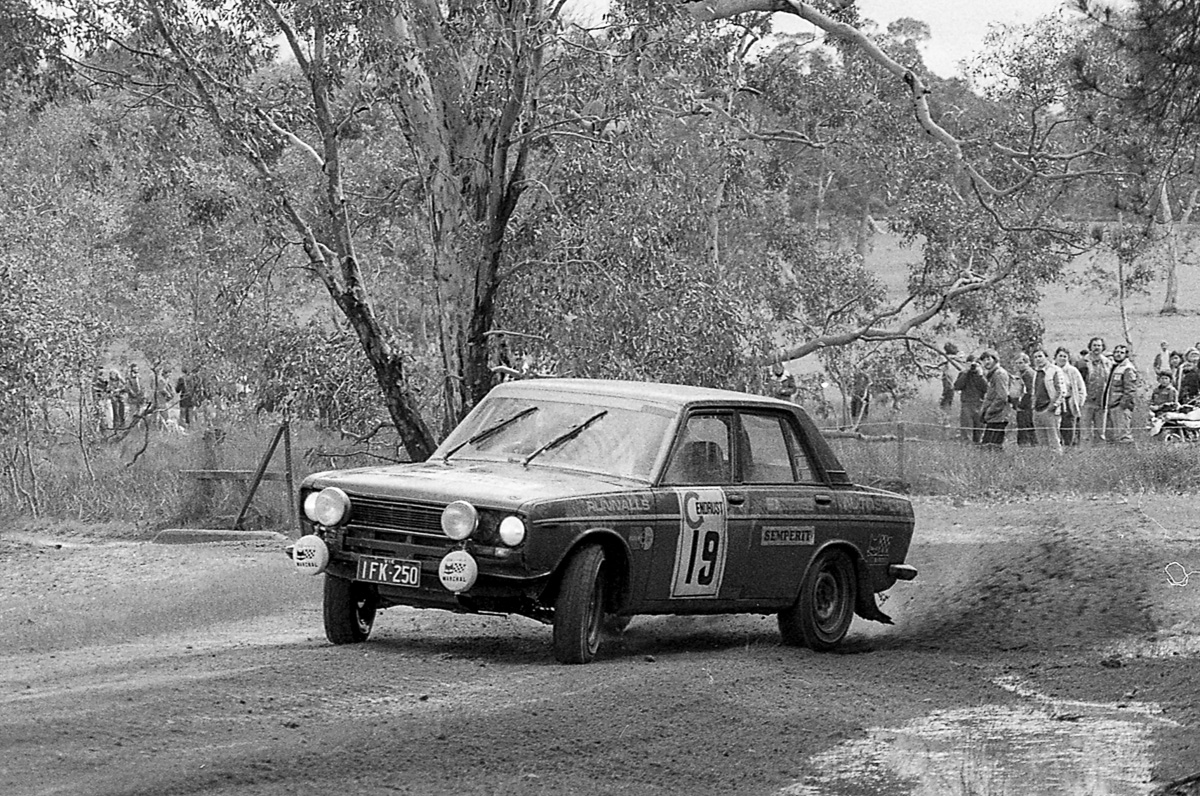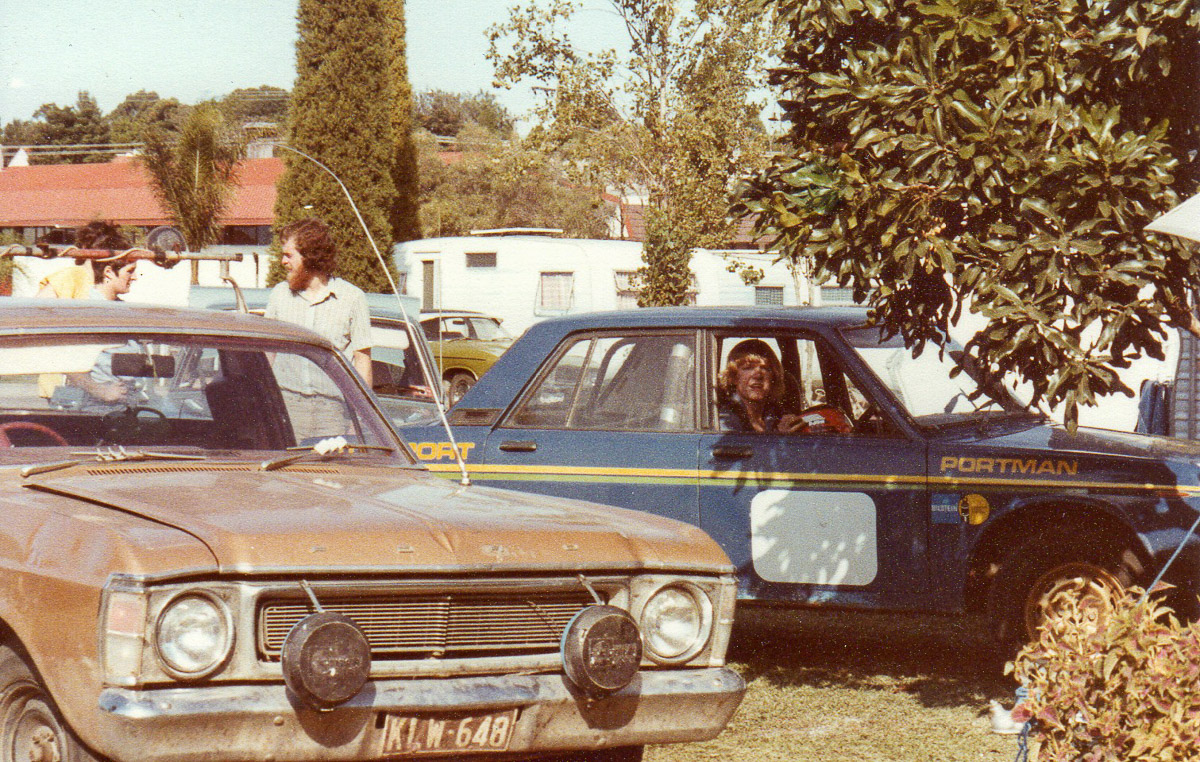During the hot months of the 1976/1977 Victorian summer Geoff made contact with Hugh Venables (one of his mates from Eltham High) and asked if Hugh could, with his mate Joe Basset-Smith, “freshen up” IFK 250’s 1800cc engine.
Hugh remembers: “The engine was a stock 180B with a single Weber and was in good condition, requiring only a set of rings and bearings and valve re-seating.
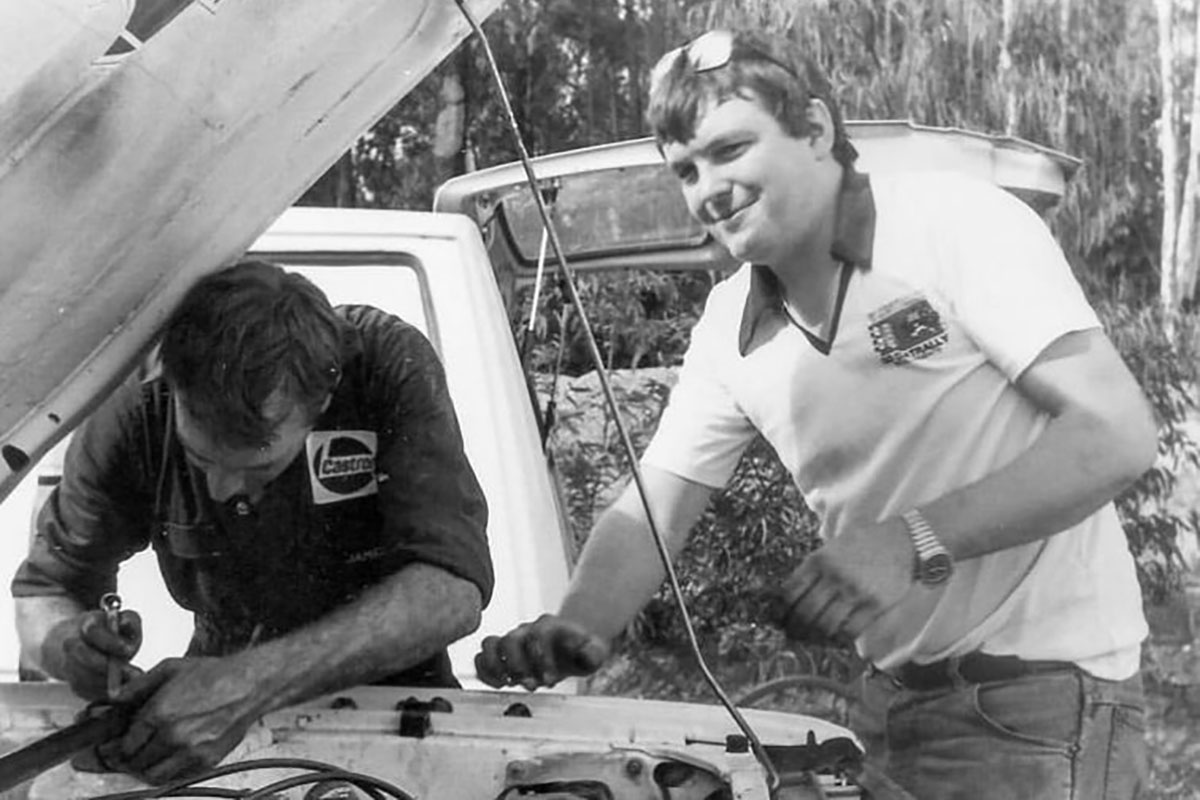
Robert Neilson, who had faithfully looked after IFK for a couple of years, moved to the UK to take up a senior position with API International, one of Rex Muldoon’s successful business ventures. This meant that IFK 250 was now without a mechanic and nowhere to live.
Les Collins takes up the story: “Tom (Kaitler) came up to me and said ‘now that Rob has gone to England, who will look after the car?’ So with Geoff up at Swifts Creek (where he had been posted by the Forests Commission), me at Uni in Footscray and with a bit of an idea, I took the car back to my rented flat in Moonee Ponds where it sat on the concrete pad at the back the flat.”
September saw the next VRC, the Zodiac Rally run in Gippsland, resulting in a DNF due to a busted differential.
The Forester Rally, also a VRC round, in Gippsland was held on October 1 with a far more satisfying result, this time an equal second. Geoff and his then future wife, Lisa, were to be married on this date, but the marriage had to be postponed “as one has to consider one’s priorities sometimes…”.
The final Victorian Championship round for 1977 was the George Derrick Memorial Trial, that year being held around the goldfields of St Arnaud. Another half route charted and half navigational event and another first outright to Geoff, Ross and IFK.
The final rally of 1977 in Victoria was the Alpine Rally, which had been elevated to International status. It was the first year that the Ford Escort Rally Team ran its awesome BDG engined RS1800 Escort (IYK 000) for Greg Carr, and that year backed it up with a 2-litre, single cam version (INB 115) for Colin Bond. Geoff, Ross and IFK 250 were doing a superb job, sitting in a comfortable 4th place, when the gremlins struck again on the Sunday afternoon. This time with “engine timing problems” and another forced DNF.
The truth of the matter is revealed by Les Collins: “Geoff had used that engine for a lot of events. It finally broke a crankshaft. I think when the crank broke it twisted the block. So, we started with another L18 engine block and crankshaft. Probably put the same rods and pistons back into the new block with replacement crankshaft. Still ran the single 45 Weber. Like a 110 BHP engine.”
Bye bye 1977. 1978 was on the horizon for IFK 250. That year’s results would prove to be a real pointer to the future.
Careful and fastidious planning and many late night discussions saw the team pick out the most beneficial events for ticking their collective career boxes.
To help things along in the power department, John Armitage loaned Geoff a pair of 45mm Dellorto carburettors, which Les fitted to IFK 250, along with a Bert Jones EEE camshaft.

Mild-mannered 1600
Les says: “The cam was very, very mild. The L18, with the Dellortos and the camshaft would have only had 120 bhp at the flywheel, if it was lucky! This is what Geoff used right up until we got the new works L20B FIA engine pre-1978 Alpine.”
There is a story behind the fitting of these carbies, which Les Collins tells. It goes a bit like this.
“Late one week I received a phone call from Geoff or Ross telling me to go to this guy John at Autosport in Box Hill and pick up a few go faster parts for the Datsun. Now, for a country guy cum student who drove a Mini Cooper, living in a flat above an Optometrist shop in Moonee Ponds, and who was not into mainstream rallying, to drive to this place called Box Hill was like ‘that’s just about the whole way across the city!’.
“So I got over there and had to introduce myself to Mr Armitage, upon which he welcomed me with open arms and started throwing engine parts at me!”
The “parts” would be a camshaft and a pair of Dellorto carburettors on a manifold and sometime not too much later, a 4.6 differential, “and Wow!”, exclaimed Les.
“I fitted them on a Saturday morning in a mates front yard in Maidstone. We managed to get the carbies fitted and the accelerator linkage all connected up and working and I got daring and tried to start it. After a few turns it burst into life and idled really well, but as soon as we gave it any throttle, it just died. Nothing at all!
“I had no idea what these Dellorto things were, other than John gave them to us, therefore they must be good, so I unscrewed the little top plates and had a look inside. Not knowing what I was looking at or for, I shone a torch down and there appeared to be two brass jets and a couple of holes, which logically probably should have had something in them.
“It was Saturday afternoon by this time and I rang up John at Autosport and said ‘John, I can’t drive the car!’. He just laughed and said: ‘Oh yeah, one of my customers wanted some main jets so I just took them out and forgot all about it. So come over right now and I’ll sort it out for you!’ And another cross town trip to Box Hill – the second – saw a very embarrassed JRA provide me with all the correct stuff and some helpful tips on how to tune it up.”
Peter Gale, or Twigger as he’s known, adds his own story of the day of the twin carbies: “We eventually took it out for a quick squirt to see how it ran, but with no bonnet and rough ‘rub down’ paintwork and it looked pretty rough.
“We got stopped by a copper, thankfully not for speeding. He asked where we were from, we said just around the corner and we were just doing a test drive. He said it had to have a bonnet. He was quite reasonable, I guess he realised it was a rally car not a hoon car, so he told us to go home and put it on.”
Fastest time on an ARC stage
Prior to the first event of the year, the Castrol International, the car had been repainted to dark blue in Bob Napier’s (an RAAF officer who was studying Engineering with Les Collins) rental house in North Sunshine and displayed yellow and green side stripes, together with yellow “Autosport” signwriting on the rear guards – and it looked a picture.
With new power and new paint, the now proudly and loudly Autosport-sponsored IFK 250 was off to the media savvy and spectator heavy Castrol International in Canberra for a solid sixth place finish.
The Australian Rally Championship that year commenced with the Queensland round, the Lutwyche Shopping Village Rally. While Geoff really had the bit between his teeth, it was the event where the low seeding number really showed its consequences.
Les picks up on the tale: “120 bhp, L18 block, 4.6:1 open diff. Geoff got fastest time on the first stage of the Queensland round. That stage was used for seeding the field, so the fastest car on that stage would start first for the rest of the rally. He beat the works Datsun 710s of Fury and Dunkerton and Carr and Bondy’s Escorts, but who was he? He wasn’t allowed to start in front of the works cars, even though that was his right.”
The time set by Geoff was certainly fastest, but after some deliberating between other crews and event officials it was resolved that “Portman is not Nationally Classified, so he can’t start first, he will have to start behind all the Classified Drivers”. So, no IFK 250 as first car on the road, as there probably should have been – at least morally.
Geoff was more forgiving about the incident than some, but the episode obviously left a bitter taste in a few mouths, as Geoff, Ross, as well as Les, Twigger and Tom all mentioned this rally during research discussions with the author.
Notwithstanding the politics, or outcomes of the decision, a DNF resulted for IFK 250 in the forests around Beerburrum, Imbil and Kenilworth, north of Brisbane, that night.
While in a splendid fifth place, Geoff hooked the LHF wheel in a culvert and part way around the corner was a drain that caught the wheel and put the wheel and the strut into Ross’ foot well. And that was that.
Down in Victoria, there was pressure for a repeat performance of the ’77 win in the Experts Trial in July. Again, a round of the Victorian Rally Championship, it was once more held in the Puckapunyal Army Range using the magnificent, smooth, fast and totally devoid of trees roads, and later in the evening, the forests surrounding Costerfield and Graytown.
Geoff and Ross powered through the mud, filth and unexploded ordinance of the Army Range of that wet Experts event, to what was becoming a usual first place.
Back onto the Australian Rally Championship trail, the postponed-from-mid-June Bega Valley Rally was on the agenda for July 29, just a week after the Experts Trial.
The fast, smooth forest and shire roads which the Bega Rally had been famous for were a welcome change from the tight Heathcote forests of the previous event. Geoff was driving his heart out, but even his significant skills could not make up the deficit in power, handling and support that was provided to the Ford Escorts of Colin Bond and Greg Carr, and the factory Datsuns of Ross Dunkerton and George Fury. Definitely, Geoff was by far the “best of the rest”, but that’s just not enough sometimes.
Fourth place was good reward. An added bonus was a few more Australian Championship points.
A short two weeks later the Readyplan (a new name for the Riverland) Rally came along. This time the opposition included Peter Brock in one of George Shepheard’s Holden Dealer Team Holden Geminis.
Through the sandy, flat deserts of Northern Victoria, from Echuca, through the Sunset country and Coombah and back to Deniliquin, it was very wet and presented a challenge to all the crews. In the end, Geoff and Ross took the win, with Brockie in second place. Peter was impressed by the young pair of foresters in the old 1600.
There were, however, a few issues to overcome on the way to the Readyplan, which Les Collins explains:
“Then there was the time I got electrocuted before I got my electrical engineering degree!
“We wanted to do the Readyplan Rally in Victoria. When Geoff and Ross came and picked up the car the day before the event the boys decided that they needed a roo bar. Not needed a roo bar, but NEEDED a roo bar. We needed something to keep the ‘roos from the front of the car.
“Well, I thought that I could build a winning car on a piece of concrete, but I was not sure I could build a ‘roo bar. So Twigger and I built a ‘roo bar for the front of this car in the pouring rain at about 3.30 am in the morning. I borrowed an arc welder and guess what, with all that rain, I got electrocuted!
“No hospital visit, but a good whack anyway.”
Another case of the desired end result being the only justifiable outcome to a problem.
The next event, the ARC Endrust Rally in South Australia, proved to be another wettish event but provided Geoff’s best result thus far. No doubt the fitment of yet another loan part from John Armitage, a 4.625:1 ratio differential – but this time with a limited slip centre – assisted. Second outright in an Australian Rally Championship round was a fine reward for all that hard work which had been done during the year.
With only an L18 engine and a Z ‘box!
Following the great result in South Australia (where he was bettered only by Colin Bond in a 240 plus bhp, BDG engined, 5-speed, 5-link rear end works Ford Escort – at that time the Escort was the fastest rally car in the world), all eyes were on the forthcoming 1978 Repco Alpine Rally in late November.
Then, after a testing mishap in Swifts Creek, Les had some panel beating to do after a misjudged hand brake turn resulted in some panel damage.
“Geoff rolled it on me, during a test session. He tipped it onto its left hand side. The whole side was damaged, but it had not touched the roof, and here was the Alpine to be run, my study to be done, fourth year exams coming up and now we had a major panel beating effort on top of that!”
But all was not lost as not long after the Endrust and the testing ‘mishap’, a phone call was made to Geoff which would help to help bridge the gap between IFK 250 and the works cars. Particularly those Ford Escorts…
It would be the beginning of the conversion of IFK 250 from a 1600 in sheep’s clothing to a 710 in sheep’s clothing. There was no wolf. Or was his name Portman?

Stripping a Datsun 710 SSS rally car
John Armitage had a pretty close relationship, both personal and business wise, with Howard Marsden. Marsden was, amongst other duties he performed for Datsun, managing the factory Datsun Rally Team, run out of a large workshop at the side of the Nissan/Datsun spare parts warehouse complex in Cheltenham Road, Braeside.
John had, through his contacts at Datsun, for some time been able to kit out his immaculate 180B SSS rally car with some (otherwise unobtainable!) parts courtesy of the Datsun boys.
After the ‘stump in the dust’ incident in the Marchal Rallye, John had been diligently working on ways and means to assist Geoff and his promising future rally endeavours. That assistance not only included the loan of some go-faster parts (the Dellortos, cam and the diff) and SEV Marchal Driving lights provided through his Autosport motor sport component supply business in Box Hill, but John had been working on Howard to also assist Geoff.
At the time, Nissan had some ex-Southern Cross Rally Violet 710 SSS cars sitting in what was affectionately called “the bone yard” at the Braeside Nissan/Datsun complex, and on occasions some parts had mysteriously gone missing, only to end up in the hands of spurious Datsun drivers all over Australia.
John’s sprinkling of “Armitage fairy dust” over Howard would soon pay dividends.
Les continues with the story: “I got a call from Geoff to tell me to go and grab a car from ‘Uncle’ John Armitage at Autosport and get down to Datsun at Braeside and pick up some parts for the 1600. That sounded like a bright opening for a young man, so off I went. I really did not know the guys at Datsun at that time, so it was to be a learning experience. I had no idea of what to expect.
“John Armitage had an ex-Wormald Security 4-door Datsun 120Y which he used for shop deliveries. And it was buggered! The fellows at Datsun were used to seeing this car and John thought that it would make entry to the complex a bit less complicated for me. So we used this poor car to go backwards and forward to Braeside to collect bits.
“I don’t know how many trips we did in that 120Y to pick up parts, but it was more than a few.
“Out the back was a big bitumen area and there were huge dump-masters which were full of unwanted stock. Books, catalogues, advertising material and lots of spare parts – all dead stock which would just get thrown out, and the 710s were parked next the dump-masters in the bone yard. The 710s came in on a carnet, so Nissan were not going to send them back or sell them, so they had to be destroyed, which was by taking them to the crusher.
“I was allowed to pick anything off one of the 710s, so I did! I even got a 710 tacho – a 10,000 rpm one –and now it’s in Neil Taylor’s 710! (Neil Taylor has reconstructed a replica of the 1977 Rauno Aaltonen/Jeff Beaumont Southern Cross Rally winning 710 SSS, which has been universally acknowledged to be the most faithful replica of a “works rally” 710 anywhere in the world). So it was time spent in a very worthwhile fashion. I took out every nut and bolt and anything which I thought we could use from those cars.”
The 710s came into Australia for competition on a Customs import carnet, so as such Datsun had to send them back to Japan as complete “original as imported” vehicles when the carnet expired, or pay the exorbitant import tax to retain them in Australia. Or perhaps allow a badly damaged immobile vehicle that’s largely complete “original as imported” vehicle to be totally destroyed under customs supervision in an automotive crusher.
After a thorough stripping, in order to have the 710 ready to pass a Customs inspection, it required some imaginative thinking to have it (at the very least) look somewhat like they did upon arrival in Australia, but with reasonable allowance for “rally usage”.
As things turned out, not long before the invitation to rape the 710, one of Geoff’s mates had bought a “New Guinea” Datsun 1600, imported by an expatriate, which came as standard with no heater and front drum brakes (!) and which was intended to be converted into a rally car.
Les again, this time with a big grin: “So we removed all that stuff from the PNG car and bolted it back into the 710. We replaced the stuff we took out with 240K stuff which at least looked as if was more suitable for competition. There was nothing worthwhile left on the 710 in the end – it was just a mobile body shell – equipped with standard 1600 seats and running gear with front drum brakes and 13 inch steel rims!
“We got a complete front and rear end suspension, Option 1 gearbox, a 5.1:1 LSD, half shafts, rear shocks, works brakes, works struts, cross members, radiators, oil coolers, hydraulic handbrakes, brake lines, gear stick knob – the whole lot!” And later on, a very special engine!
Geoff and IFK 250 were most certainly going to get some big improvements for the Alpine Rally. And lots of work for Les and the faithful crew.
IFK 250 was duly upgraded courtesy of the Datsun 710 parts, including front struts (now the height adjustable works Nissan Tokico units, with hub drives for the Halda), and associated components such as fully-adjustable for camber and caster aluminium tops; the gearbox was now a direct fifth Option 1 unit; the differential ratio was now 5.1:1 and with a limited slip centre.
A 710 rear cross member and trailing arms added some additional strength to the suspension (and width to the track, requiring wheel arch panel beating to clear the rear tyres (proper flaring would come later) and the brakes were now ventilated discs with 4-spot calipers all round.
Tyres were still Semperits (rather than the far superior Dunlop SP52 tyres that the works team were using), and the car still sat on 240Z 14 inch steel rims, painted gold to emulate the colour of the Datsun works Enkei alloy wheels.
Geoff’s result (second outright) in the Endrust Rally earlier in the year had pleased Howard Marsden. Datsun had chosen not to enter any of its cars in the Alpine that year, but the wily Marsden was keen to do whatever he could to prevent a Ford/Alpine victory.
The special present was just what IFK needed and with it, Geoff and IFK really hit the big time, with champagne popping everywhere. But all this hard driving and consequent success has some detriments to the car’s body and chassis. IFK is still shod with Semperit tyres, its garage area is an open-air concrete pad in the laneway at the back of an Optometrist’s Shop in Moonee Ponds.
A few days later, and no doubt with an extra dose of that (by now) well used fairy dust sprinkled by John Armitage, the final part of the “Alpine Presents” landed in Geoff’s lap.
Photos in this feature have been contributed by: Bruce Keys, Dallas Dogger, John Lemm, Ken Cusack, David Balfour, Ray Berghouse/Chevron Publishing, Peter Whitten, Ian Long, Tom Kaitler, B Team Rally Media.


